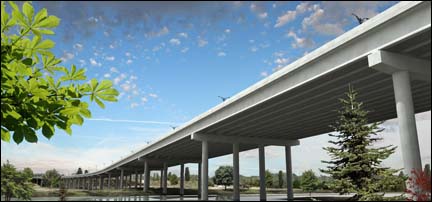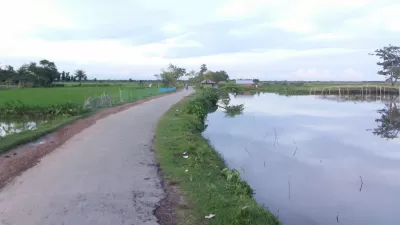Our nation's roads must be greener, says David Wenzel of HNTB. A green road is one that is designed, built and maintained in a manner that protects and enhances the environment, lessens the impact on its surroundings, and encourages mass transit.
 Our nation's roads must be greener.
Our nation's roads must be greener.
They need to last longer and live harmoniously with the environment. They should be less congested and less costly, and they should utilize new technology, new material and new thinking.
The time is now.
Never in our nation's history has this been such an important issue. Global climate change, crumbling national infrastructure and precarious financial conditions have created a perfect storm - and a golden opportunity - for the transportation sector.
So, what is a green road?
One that's designed, built and maintained in a manner that protects and enhances the environment. It lessens the impact on its surroundings, and it encourages mass transit, thereby reducing carbon emissions and fuel consumption.
The means to green are plentiful:
Recycled material. For economic and environmental reasons, materials such as powdered rubber tires, glass and broken concrete can be used as road surfaces and underlayers.

Habitat preservation. Whether building new streets or retrofitting existing ones, designers need to be aware of the road's immediate surroundings. Roadside plantings should be done whenever possible, and measures should be put in place to protect native plant and animal life. For example, one recent HNTB project directed the drainage runoff from a bridge into a detention basin rather than the wetlands habitat of the Blanding's turtle.
Green drainage. Another recent project in Wisconsin converted drainage water to a positive purpose. Diverting it to "rain gardens" along a major boulevard enhanced the street's frontage through native perennial plantings fed by the drainage, which is ultimately filtered back as groundwater.
Permeable pavement. As paving of roadways and parking areas increases so does erosion, and the hard costs associated with treating and handling related drainage. Pervious pavement allows postconstruction stormwater infiltration rates to remain the same as before construction began. Introducing permeable pavement allows storm water to help recharge the local aquifer and effectively cleans roadway pollutants and total suspended solids from runoff.
Plastic fibers. In our fight against corrosion, we can construct concrete roads reinforced with plastic fibers. Though the technology is still in its infancy, the fibers increase structural integrity and create a denser concrete that is difficult for water to permeate, thereby increasing sustainability.
Self-healing streets. In a groundbreaking technology that could lengthen the time before a street or bridge requires significant repair, an auto-healing epoxy can fill tiny cracks in the concrete as quickly as they appear.

Green lanes. Cities need to build lanes that will be dedicated to buses, ride-sharing commuters and energy-efficient vehicles. These initiatives encourage mass transit and, ideally, reduce carbon emissions and fuel consumption.
Other green initiatives include installing bioswales, or sloping vegetated channels, that improve the quality of roadway runoff by removing pollutants; replacing halogen bulbs in street lights with LED assemblies, which are more energy efficient; and installing sensors in roadways, which monitor structure health and help evaluate concrete performance.
To push forward these goals, HNTB has developed a nationwide standards manual with information on environmental roadway planning and design. The manual also includes major project case studies, which are reviewed by green design teams to independently evaluate measures aimed at making infrastructure design more sustainable.
The time is now to build greener, smarter and better roads that serve not only our generation but generations to come.
David Wenzel, AICP, LEED® AP is Vice-President, National Chair, HNTB Pre-Design and Planning Services. David has more than 30 years of professional experience, of which eight years were spent in the public sector, including serving as Community Development Director of Thornton, CO and Assistant Director of Planning for the City of Dallas, TX. He holds a master's degree in Public and Environmental Affairs from Indiana University and a bachelor's degree in Urban Planning from the University of Cincinnati.

Alabama: Trump Terminates Settlements for Black Communities Harmed By Raw Sewage
Trump deemed the landmark civil rights agreement “illegal DEI and environmental justice policy.”

Study: Maui’s Plan to Convert Vacation Rentals to Long-Term Housing Could Cause Nearly $1 Billion Economic Loss
The plan would reduce visitor accommodation by 25% resulting in 1,900 jobs lost.

Planetizen Federal Action Tracker
A weekly monitor of how Trump’s orders and actions are impacting planners and planning in America.

Wind Energy on the Rise Despite Federal Policy Reversal
The Trump administration is revoking federal support for renewable energy, but demand for new projects continues unabated.

Passengers Flock to Caltrain After Electrification
The new electric trains are running faster and more reliably, leading to strong ridership growth on the Bay Area rail system.

Texas Churches Rally Behind ‘Yes in God’s Back Yard’ Legislation
Religious leaders want the state to reduce zoning regulations to streamline leasing church-owned land to housing developers.
Urban Design for Planners 1: Software Tools
This six-course series explores essential urban design concepts using open source software and equips planners with the tools they need to participate fully in the urban design process.
Planning for Universal Design
Learn the tools for implementing Universal Design in planning regulations.
Caltrans
Smith Gee Studio
Institute for Housing and Urban Development Studies (IHS)
City of Grandview
Harvard GSD Executive Education
Toledo-Lucas County Plan Commissions
Salt Lake City
NYU Wagner Graduate School of Public Service



























